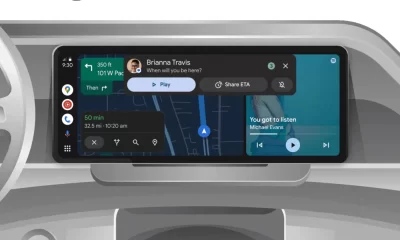Google rolleout real-time search updates, Gemini dark theme changes, and new features in Google Photos and YouTube

Google is experimenting with multiple updates across its platforms, including Google Search, Gemini, Google Photos, and YouTube. Let’s explore these new features and enhancements:
Google Testing Real-Time Search Results with Conversational AI
Google is testing a real-time update feature for its Search app that could make search results more dynamic, similar to interactions with AI chatbots like Gemini. The goal is to offer a more conversational search experience, aligning it with the growing trend of Generative AI (Gen AI).
Key Highlights:
- Real-Time Updates with Voice Search:
- Google is reportedly testing a version of the Search app where results refresh in real-time as users speak. This would allow users to have a more interactive experience, similar to having a conversation with an AI chatbot.
- According to leaked demos on X (formerly Twitter) by AssembleDebug, users can ask follow-up questions, and the search results page will update continuously without requiring manual input.
- Integration with Generative AI:
- This update appears to mimic the capabilities of Gemini Live, an AI platform from Google that already supports conversational responses. Google seems to be focusing on making its Search feature more intuitive and interactive, catering to users who prefer AI-driven solutions for quick and sequential answers.
- Currently, Google Search provides Gemini AI Overviews, but it is not as seamless as a real-time chatbot experience. This new feature could bridge that gap, offering a continuous conversational flow without interruptions.
- What’s Next?:
- Although this conversational search mode is not yet officially available, Google seems to be testing it internally. Given the existing integration of conversational AI in other Google services, it might soon become a standard feature in the Search app.
Gemini Gets a New Dark Theme Update
Google’s Gemini platform recently underwent some visual changes, particularly to its dark theme on the web. This update reflects Google’s ongoing efforts to improve the user experience across its services.
Key Changes:
- Lighter Dark Theme:
- The dark mode now features a lighter shade of gray rather than the previously used deep black or dark gray. This aligns Gemini’s appearance more closely with Google Search’s dark theme, providing a unified look across Google’s platforms.
- Consistent Design Language:
- The update has been applied to various parts of Gemini’s web interface, including the side panel and search fields. However, some sections like the Extensions page still show inconsistencies, indicating that a full rollout might be in progress.
- Android and iOS Updates:
- While the web and Android versions of Gemini have received this new look, similar changes for iOS users have yet to be confirmed.
Google Photos Introduces a New ‘Updates’ Page
Google Photos has revamped its interface by replacing the “Sharing” tab with a new “Updates” feed, making it easier for users to stay informed about recent activities.
Features of the New Updates Page:
- Organized Activity Feed:
- The Updates feed now organizes notifications based on timeframes such as “today,” “yesterday,” “this week,” and “last month.” This helps users quickly find recent changes or updates in their shared content.
- Enhanced Accessibility:
- The new feed displays updates related to shared albums, conversations, partner sharing, and memory updates, giving users a comprehensive view of their photo-sharing activities.
- Users can now easily access shared albums by navigating to the “Collections” tab, where they can filter between “All,” “Shared with me,” and “My albums.”
- Rollout and Availability:
- This new feature is being gradually rolled out to Android and iOS users, with full availability expected in the coming weeks.
YouTube’s Playback Speed Control Redesign
YouTube has introduced a more user-friendly design for adjusting playback speed in its Android and iOS apps, focusing on making the interface simpler and easier to use.
What’s New in Playback Speed Controls:
- Compact and Accessible UI:
- The previous playback speed options appeared as a tall list occupying a significant part of the screen. The new design features a shorter, bottom-row UI that is easier to access with one hand.
- The updated control layout includes five preset speed options: 0.25x, 1.0x (Normal), 1.25x, 1.5x, and 2.0x, displayed in pill-shaped buttons for easy selection.
- Slider for Fine-Tuning:
- A new slider allows users to adjust the playback speed in increments of 0.5x, providing more granular control over video playback.
- The slider is complemented by ‘plus’ and ‘minus’ buttons, letting users quickly increase or decrease the speed.
- Server-Side Rollout:
- The redesign is being rolled out as a server-side update, available with version 19.43 on Android and 19.44 on iOS. Users should see this new feature without needing to update the app manually.
Conclusion
Google’s latest updates show its commitment to enhancing user experience across its various apps and services. By testing real-time search results, refining visual elements in Gemini, overhauling the sharing experience in Google Photos, and simplifying playback controls in YouTube, Google is setting the stage for a more intuitive and seamless interaction across its ecosystem. These changes aim to align Google’s offerings with the increasing demand for AI-driven, user-friendly features, making it easier for users to access information and interact with content on their devices.
As Google continues to experiment and refine these features, users can expect a more integrated experience across its platforms, driven by a blend of AI capabilities and user-centered design improvements.
Google Meet gets a fresh new look with Material 3 design

Google Meet is getting a big update to its look, thanks to the new Material 3 design. This change brings a cleaner and more modern style to the video calling app, making it easier and more enjoyable to use.
With Material 3, Google Meet now has rounder buttons, softer colors, and better spacing between elements. The main controls, like the microphone, camera, and end call buttons, are now larger and easier to tap. The icons and text are also clearer, which helps users find what they need quickly during a call.
Another improvement is the new “expressive” color system. This feature lets the app’s colors match your device’s wallpaper or theme, giving each user a unique and personalized experience. The changes also make Google Meet more accessible, as the new design is easier to read and use for everyone, including people with vision difficulties.
These updates are rolling out to both web and mobile versions of Google Meet. Google says the new look will help people feel more comfortable and focused during their meetings. Overall, the Material 3 update makes Google Meet not only look better but also work better for all its users.
Android
Easy ways to change Android Auto’s look with light and dark themes

Android Auto is a helpful tool that lets you use your phone’s apps safely while driving. It connects your phone to your car’s screen, making it easier to use maps, music, and calls. One of the features many people like is the ability to change how Android Auto looks by switching between light and dark themes.
How to switch between light and dark themes
Android Auto offers two main themes: light and dark. The light theme uses brighter colors, which can make the screen easier to see during the day. The dark theme uses darker colors, which can be more comfortable for your eyes at night or in low light.
To change the theme, follow these steps:
- Open the Android Auto app on your phone.
- Go to the settings menu.
- Find the “Theme” option.
- Choose between “Light,” “Dark,” or “Set by car” (this lets your car decide the theme based on the time of day or your car’s settings).
Why themes matter
Using the right theme can make driving safer and more comfortable. The light theme is good for bright days, while the dark theme helps reduce glare at night. Having these options means you can pick what works best for you, making Android Auto easier to use in any condition.
In short, Android Auto’s theme options are simple to use and help you drive more safely by making the screen easy to see, no matter the time of day.
Google Drive and Files by Google get fresh updates for easier use

Google is rolling out some helpful updates to two of its popular apps: Google Drive and Files by Google. These changes are designed to make managing your files and watching videos much smoother.
First, Google Drive is getting a new video player. Now, when you upload a video to Drive and open it, you’ll notice a fresh look that matches Google’s latest design style. The controls, like play and pause, are easier to use and look cleaner. This update makes it simpler to watch videos directly in Drive without needing to download them first.
Meanwhile, the Files by Google app is also getting a makeover. The app is adopting Google’s Material 3 design, which means it looks brighter and more modern. The buttons and menus are easier to see and use, making it simpler to find, move, and organize your files. There are also new color options and improved icons, so everything feels more user-friendly.
Both updates show Google’s commitment to making its apps more helpful and enjoyable to use. Whether you’re watching videos in Drive or sorting files on your phone, these changes aim to save you time and make things less complicated. If you use these apps, keep an eye out for these new features—they should arrive soon!
-

 Apps1 year ago
Apps1 year agoGboard Proofread feature will support selected text
-

 News1 year ago
News1 year agoSamsung USA crafting One UI 6.1.1
-

 Apps1 year ago
Apps1 year agoGoogle Contacts app testing new Besties Widget
-

 AI12 months ago
AI12 months agoGoogle Pixel 9 Pro may come with a complimentary one-year Gemini Advanced subscription
-

 Apps12 months ago
Apps12 months agoGoogle working on a new video editing feature for its Photo app
-

 News1 year ago
News1 year agoBreaking: Samsung Galaxy S22 may get Galaxy AI features
-

 Apps12 months ago
Apps12 months agoGoogle Maps lets you report traffic jams and accidents on Apple CarPlay, but not on Android Auto
-

 Apps1 year ago
Apps1 year agoGoogle Messages app will transform MMS chats into RCS










